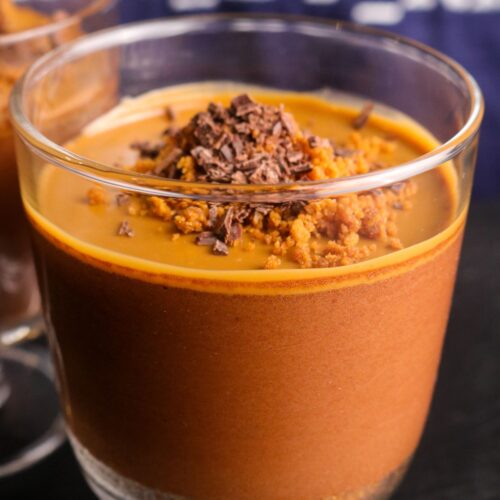
Biscoff and Chocolate Mousse
Try this egg free decadent biscoff and chocolate mousse. A buttery cookie base with an airy chocolate mousse, finished with a biscoff glaze.
Equipment
- Large mixing bowl
- Heatproof bowl
- Electric whisk
- 4 individual ramekins (3" diameter and 1.5" height) or 2 large ramekins (3" diameter and 3" height)
Ingredients
For the base:
- 10 biscoff biscuits
- 2 tbsp butter melted
For the mousse:
- 170 ml aquafaba – from 1x400g tin of chickpeas in unsalted water*
- 1/4 tsp cream of tartar or 1/2 tsp lemon juice
- 140 g chocolate I prefer a 70% dark chocolate but use your favourite bar here. Keep extra for garnishing
- 2 tbsp caster sugar
For the garnishing:
- 4 tbsp smooth biscoff spread
Instructions
For the base:
- First place the biscoff biscuits into a zip-lock bag and crush them with a rolling pin until coarsely ground. Transfer to a small bowl
- Then pour over the melted butter and mix until it forms a 'wet sand' like appearance. Split this evenly between 4 individual ramekins or 2 large ramekins, making sure to leave aside a little extra for garnishing
- Press the biscuit base down into the ramekins with the back of the spoon into an even layer. Then transfer to the refrigerator to chill
For the aquafaba mousse:
- Roughly chop the chocolate and transfer to a heatproof bowl. I recommend melting this over a bain marie rather than a microwave as the microwave can sometimes overheat the chocolate causing it to seize. Once melted leave aside to cool
- Now drain a tin of chickpeas over a clean bowl to separate the aquafaba (chickpea water). There must be no grease/oil/fat residue in this bowl or on any other utensils used. If fat comes into contact with the aquafaba it will not whisk up
- Add the cream of tartar or lemon juice to the aquafaba and begin whisking with an electric whisk
- Once the aquafaba starts to turn pale and frothy, add the caster sugar and continue to whisk. The sugar provides additional structure here
- Continue whisking until you reach a stiff peak stage. This will be when you lift the whisk out and it forms firm tips in the aquafaba which stand up straight and hold their shape. Aquafaba cannot be over whisked so if unsure, keep whisking. This process can take 7-10 minutes
- Ensure the chocolate has cooled to a point where it is no longer warm but is still runny before carrying out the next step
- Add around 1/5th of the whipped aquafaba to the chocolate and gently fold in until incorporated
- Then add another 1/5th of the whipped aquafaba and repeat. Ensure to fold rather than whisk as we want to retain all the air
- Then add the chocolate and aquafaba mixture back into the large bowl of whipped aquafaba. Continue to gently fold until incorporated. It is perfectly normal for the aquafaba to deflate during this process. The resulting mixture should be thick, creamy, glossy, and airy. It will be of a spoonable consistency
- Divide equally between the 4 individual sized ramekins or 2 large ramekins that we had placed the biscuit base in. Transfer back into the refrigerator for a minimum of 6 hours
For garnishing:
- Melt the biscoff spread in the microwave in very short bursts until pourable. Then pour over the chilled and set mousse. Rotate the ramekins to spread an even layer. Place back into the refrigerator for 5 minutes
- Top with some of the extra ground biscuits from earlier and some grated chocolate
Notes
- *Different brands of chickpea tins can have different volumes of aquafaba. If like myself you value precision, I would recommend measuring the volume of aquafaba. You should have anywhere around 150-170ml
- The ratio of chocolate to aquafaba is around 0.8:1 though a few grams here and there won’t make a difference when working with such a small amount.
- I.e. if you end up with 160ml of aquafaba, you would want to use 128g (or rounded to 130g) of chocolate
- Or if you’re very unlucky and end up with 150ml of aquafaba, you would want to use 120g
- This is not an essential step, but some of you may want to scale up the recipe (for a party for e.g.) and the extra precision will help!